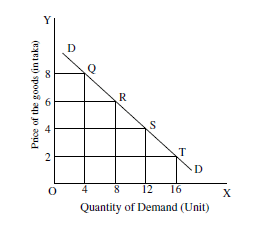25 Important Basic Elements of Demand Questions and Answers [With PDF]
The fifth chapter of our economics learning course is “Basic Elements of Demand.” In this article, we’ll learn the 25 most important “Basic Elements of Demand” questions and their answers.
These simple questions and answers will help you quickly understand the basic concepts of demand, such as what demand is, its features, assumptions, determinants of demand, the law of demand, demand schedules, demand curves, changes in demand, and much more.
By reading this post, you can quickly prepare for economics courses and other competitive exams such as Vivas, job interviews, and school and college exams.
So let’s get started.
Basic Elements of Demand Questions and Answers
The 25 most important “basic elements of demand” questions and answers are as follows:
Question 01: What is demand?
Answer: In general, “demand” refers to a desire to obtain or enjoy a product. However, in economics, the term “demand” has a specific meaning. Here, the ability is specifically associated with desire. Demand is the desire to get a product, which depends on whether or not people can afford it and are willing to spend money on it.
Question 02: What are the three conditions that must be met in order to make a demand in economics?
Answer: In economics, three conditions must be met in order to make a demand. They are as follows:
- the desire to obtain any goods,
- more than the necessary purchasing capacity, and
- the desire to spend money in order to obtain that good
Question 03: What are the key features of demand?
Answer: The following are the key features of demand:
- One important thing about demand is that it is always based on price.
- The consumer’s desire for a product, their income, the cost of substitutes and complementary products, etc., all have an impact on the demand for a given good or service.
- It is worth noting that an individual’s demand differs from market demand.
- Individual demand is the amount of a good or service that a specific person is willing to buy at a particular price over time, such as per day, per week, per month, etc.
- Market demand is the total amount that all consumers of a good or service are willing to purchase over time at a specific price.
Question 04: What is the formula for determining demand?
Answer: The following formula is used to determine the demand:
Dx = f(Px, PY, Y, T,…)
Where,
Px denotes the price per unit of good X.
PY denotes the price of the related goods.
Y represents the consumer’s income.
T represents the consumer’s tastes and preferences.
Question 05: What are the leading determinants of demand?
Answer: The leading determinants of demand are as follows:
- Price of the Commodity
- Prices of Related Commodities
- Level of Income
- Expected Change in Price
- The size of the population,
- Suppliers’ marketing and sales campaigns,
- Sellers’ selling costs
- The buyer’s tastes and preferences,
- Distribution of income and wealth
- Future income of the buyer
- Cost of living
Question 06: What is the law of demand?
Answer: The law of demand states that “all other things being equal or unchanging, at any given time, if the price of the good declines, demand rises, and if the price increases, demand declines.”
The other factors being constant here mean that the buyer’s preferences, routines, and tastes won’t change, along with the buyer’s income and the cost of substitute goods, etc.
The functional relationship between price and quantity demanded is described by the law of demand.
Question 07: What are the assumptions of the law of demand?
Answer: The laws of demand are established based on several assumptions. These are the following:
- The buyer or consumer is rational.
- The buyer’s tastes and habits will remain unchanged.
- The buyer’s income will remain unchanged.
- There will be no change in the prices of other related products.
- There will be no change in the number of buyers on the market.
- There will be perfectly competitive markets.
Question 08: What are the exceptions to the law of demand?
Answer: The following are the reasons for exceptions to the law of demand:
- Expected change in the price of a good
- If the rate of change in consumer income is greater than the rate of change in the price of the consumer good, the law of demand may not be effective.
- A change in fashion and tastes has an impact on the commodity market.
- The law of demand may also be violated in the case of complementary goods.
- Situational reasons can also be exceptions to the demand law.
- The buyer is often unable to judge the quality of the product due to ignorance. In this case, if the price of the product increases, the product is thought to be very valuable and the product is purchased in larger quantities. In this case, the demand law does not apply.
Question 09: What are substitute goods?
Answer: One of the two goods is a substitute for the other when it can be used instead of the other and provide almost the same amount of utility. In other words, if an increase in the price of one good increases the demand for another, then both goods are referred to as substitute goods.
For example, tea and coffee, pen and pencil, etc. are substitutes for each other.
Question 10: What are complementary goods?
Answer: When the consumption of one of the two goods rises, the consumption of the other rises as well, the two goods are said to be complementary. In other words, if the price of one product rises while the demand for another product falls, the two products are said to be complementary goods.
For example, tea and sugar, ink and pen, petrol and car, shoes and socks, etc.
Question 11: What is the demand schedule?
Answer: A demand schedule is an equation or list that shows how much of a good people will buy at different prices at a specific time if all other things are the same.
Question 12: What are the different types of demand schedules?
The following are the two types of demand schedules:
- Individual demand schedule
- Market demand schedule
Question 13: What is the market demand schedule?
Answer: The market demand schedule is the horizontal sum of individual demand schedules.
Question 14: What is the demand curve?
Answer: A “demand curve” is a graph that shows the quantity of a good that a consumer purchases at various prices at a given time. A demand curve is a graphical representation of a demand schedule. Each demand curve point represents the demand for a specific quantity of a product at a specific price.

Question 15: What is the market demand?
Answer: Market demand is the sum of all the different needs and wants of consumers in the market at a certain price.
Question 16: What is the market demand curve?
Answer: The market demand curve shows how many of the same kind of goods different consumers are willing to buy at different prices.
Question 17: What are the reasons for the downward or negative slope of the demand curve?
Answer: Some of the major reasons for the downward or negative slope of the demand curve are listed below:
- From the law of diminishing marginal utility, it can be said that when the price of a product falls, the quantity demanded is high, and when the price is high, the quantity demanded is low. Because of this inverse relationship between demand and price, the demand curve slopes downward to the right.
- A fall in the price of a good generally increases the consumer’s real income or purchasing power. That is, if the price of a product decreases, the buyer can buy the same amount of product for less money. In this case, with the same amount of money, the buyer can buy more products than before. As a result, demand increases due to a decrease in price. Again, if the price of goods increases, the real income of the consumer decreases. In such a situation, the demand decreases as the buyer can purchase a smaller quantity of goods with his money. So the demand curve shifts to the right due to the real income effect.
- If the price of related goods is fixed, if the price of one good decreases, the consumer buys more of that good by reducing the consumption of other related goods. for example, tea and coffee. If the price of coffee falls while the price of tea remains constant, consumers will reduce their consumption of tea and increase their consumption of coffee. That is, reducing the price of coffee will increase the demand for coffee. Thus, an inverse relationship is established between the price and demand of the product. As a result, the demand curve is decreasingly sloping to the right.
Question 18: What is the demand function?
Answer: According to the law of demand, demand is dependent on price. In this case, the price of the product (P) is the independent variable, and the quantity demanded of the product (Qd) is the subordinate or dependent variable. The demand function is an equation that shows how the price and demand of a product are linked in a way that can be described by a function.
Question 19: What is the demand equation?
Answer: The equation that expresses the degree and nature of the relationship between the price of a good and the quantity demanded is called the demand equation.
The demand equation is as follows:
Qd = a- bP
Here,
Qd represents the amount of demand.
a represents the price of goods.
b represents the intercept.
P represents the slope. The slope here shows the rate of change in demand due to a change in price.
Question 20: What are the changes in quantity demanded?
Answer: If a change in the price of a good causes a change in demand even though “other things remain the same,” this means that the quantity demanded has changed. That is, a change in price will cause a change in position along the same demand curve if there is a change in the amount people want.
Question 21: What is a “change in demand”?
Answer: A change in demand refers to a decrease or increase in demand. In this case, the demand curve shifts to the right or left when other determinants of demand change other than the price of the product.
Question 22: What is an expansion in demand?
Answer: Other things being equal, if the quantity demanded of good increases when its price falls, it is called an expansion in demand.
Question 23: What is a contraction in demand?
Answer: Other things being equal, if the price of good increases and the quantity demanded of it decreases, it is called a contraction in demand.
Question 24: What are the reasons for the increase in demand?
Answer: The reasons for the increase in demand are as follows:
- Increase in consumer income
- Changes in consumer tastes
- Price reductions for related goods
Question 25: What are the reasons for the decrease in demand?
Answer: The reasons for the decrease in demand are as follows:
- Decrease in consumer income
- Changing consumer tastes
- increase in the prices of related goods.
I hope you have a good understanding of the “Basic Elements of Demand“ chapter by the end of this post.
If you read these 25 important “basic elements of demand” questions and answers on a regular basis, you will gain a better understanding of the chapter.
Don’t forget to leave a comment for us if you have any questions or if you would like to find out more information.
You can also read:
- Introduction to Economics Questions and Answers [With PDF]
- Important Concepts of Economics Questions and Answers [With PDF]
- Important Mathematical Economics Questions and Answers [With PDF]
- Important Theory of Demand Questions and Answers [With PDF]
- Important Basic Elements of Supply Questions and Answers [With PDF]






